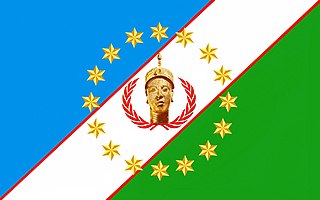Related Research Articles

Shango is an Orisha, a deity in Yoruba religion. Genealogically speaking, Shango is a royal ancestor of the Yoruba as he was the fourth Alaafin of the Oyo Kingdom prior to his posthumous deification. Shango has numerous manifestations, including Airá, Agodo, Afonja, Lubé, and Obomin. He is known for his powerful double axe (Oṣè). He is considered to be one of the most powerful rulers that Yorubaland has ever produced.

The Oyo Empire was a powerful Yoruba empire of West Africa made up of parts of present-day eastern Benin and western Nigeria. It grew to become the largest Yoruba-speaking state and rose through the outstanding organizational and administrative skills of the Yoruba people, wealth gained from trade, and its powerful Cavalry. The Oyo Empire was one of the most politically important states in the entirety of Western Africa from the mid-17th to the late 18th century, and held sway not only over most of the other kingdoms in Yorubaland, but also over nearby African states, notably the Fon Kingdom of Dahomey in the modern Republic of Benin on its west.
Ketu is a historical region in what is now the Republic of Benin, in the area of the town of Kétou (Ketu). It is one of the oldest capitals of the Yoruba-speaking people, tracing its establishment to a settlement founded by a descendant of Oduduwa, also known as Odudua, Oòdua and edua. The regents of the town were traditionally styled "Alaketu", and are related directly to Ile-Ife in present-day Nigeria.

Alaafin, or The Owner of the Palace in the Yoruba language, is the title of the king of the medieval Oyo empire and present-day Oyo town of West Africa. It is the particular title of the Oba (king) of the Oyo. It is sometimes translated as "emperor" in the context of ruler of empire. He ruled the old Oyo Empire which extended from the present day Benin republic to Nigeria originating from states in the South East and West to the North. The people under him are called Yoruba people and spoke the Yoruba Language.

Aganju is an Orisha. He is syncretized with Saint Christopher in the Cuban religion known as Santería. In Yoruba language, aginjù means a wilderness, inhospitable habitat or impenetrable locale.

The Legends of Africa reflect a wide-ranging series of kings, queens, chiefs and other leaders from across the African continent including Mali, Benin, Ghana, Nigeria, Congo, Ethiopia, Eritrea and South Africa.
King Abipa, also known as Ogbolu or Oba M'oro, was an Alaafin of the Oyo empire. He is believed to have ruled during the late sixteenth and early seventeenth centuries.
Ojigi was Alaafin of the Yoruba Oyo Empire from 1724-1735.
Orompoto was an Alaafin of the Yoruba Oyo Empire. The empire of which she ruled is located in what is modern day western and north-central Nigeria.
Ajagbo was an Alaafin of the West African Oyo Empire, whose long reign took place during the seventeenth century.
Odarawu was an Alaafin of the Oyo Empire, who ruled briefly during the late seventeenth century. He was reportedly the first Alaafin to be rejected by the Oyo Mesi.
Kanran, or Karan, was an Alaafin of the Oyo Empire. He succeeded Oba Odarawu.
Jayin was an Alaafin of the Oyo Empire.
Aganju of Oyo was a Yoruba emperor of the Oyo state, in present-day Nigeria. He was said to have been the fourth Alaafin or old Oyo.

The documented history begins when Oranyan came to rule the Oyo Empire, which became dominant in the early 17th century. The older traditions of the formerly dominant Ile-Ife kingdom are largely oral.
Gberu was an Alaafin of the Yoruba Oyo Empire. He was on the throne from 1730 to 1746.

The Yoruba people are a West African ethnic group who mainly inhabit parts of Nigeria, Benin, and Togo. The areas of these countries primarily inhabited by the Yoruba are often collectively referred to as Yorubaland. The Yoruba constitute more than 52 million people in Africa, are over a million outside the continent, and bear further representation among members of the African diaspora. The vast majority of the Yoruba population is today within the country of Nigeria, where they make up 21% of the country's population according to CIA estimations, making them one of the largest ethnic groups in Africa. Most Yoruba people speak the Yoruba language, which is the Niger-Congo language with the largest number of native or L1 speakers.
Sango Festival is an annual festival held among the Yoruba people in honour of Sango, a thunder and fire deity who was a warrior and the third king of the Oyo Empire after succeeding Ajaka his elder brother. Renamed in 2013 to World Sango Festival by the government of Oyo State, the festival is usually held in August at the palace of the Alaafin of Oyo and also observed in over forty countries around the world.
The Oyo Mesi is the privy council of Oyo, a Yoruba traditional state in Southwestern Nigeria. It dates to the medieval period, when it served as the government of a powerful pre-colonial state that was known as the Oyo empire.
References
- 1 2 Law, R. C. C. (1971). "The constitutional troubles of Ọyọ in the eighteenth century". The Journal of African History. 12 (1): 25–44. doi:10.1017/s0021853700000050. ISSN 0021-8537.
- 1 2 Johnson, Samuel (August 2011). The history of the Yorubas : from the earliest times to the beginning of the British Protectorate. ISBN 0948390891. OCLC 989713421.